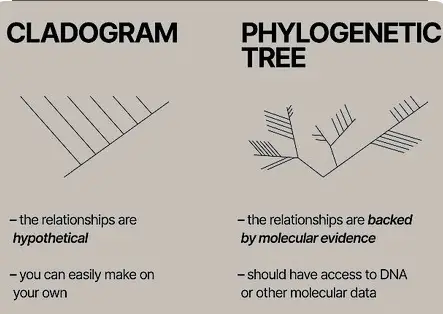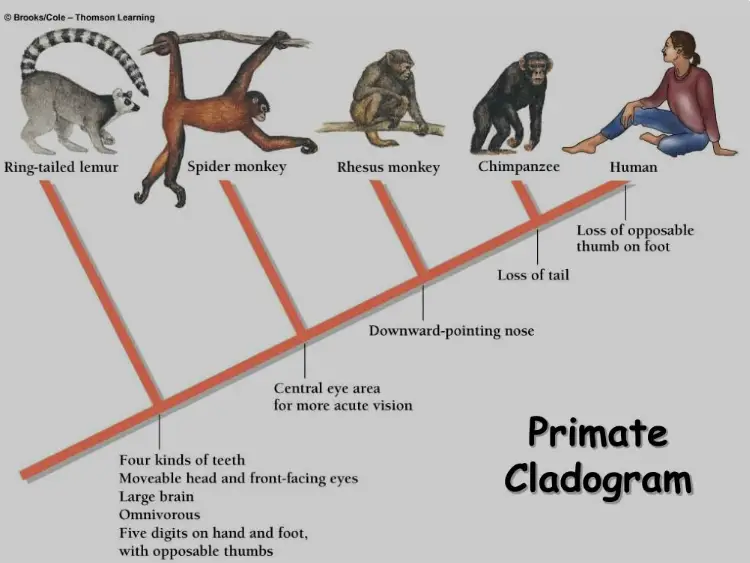Cladograms and dichotomous keys are essential tools in the field of biological classification, each serving a unique purpose in the study and identification of organisms. A cladogram is a diagram that depicts evolutionary relationships among groups of organisms, whereas a dichotomous key is a tool used for the identification of organisms based on a series of choices between alternative characteristics.
A cladogram shows how closely species are related by illustrating their evolutionary paths. In contrast, a dichotomous key is a practical guide used in the field to identify species based on a sequence of yes/no decisions about physical characteristics. The primary goal of these tools is to simplify complex biological information into understandable and usable formats.
Understanding these tools not only enhances our grasp of biological diversity and evolution but also aids in important tasks such as conservation and ecological assessment. Both tools utilize different methodologies to categorize and identify life forms, reflecting the diversity of approaches in the biological sciences.

Basic Concepts
Taxonomy Basics
Taxonomy is the science of naming, describing, and classifying organisms into a structured system that reflects natural relationships. The main goal of taxonomy is to provide clarity and consistency in the naming of organisms, ensuring that each species has a unique and universally accepted name. This system is crucial for the scientific community to communicate specific information about species and their relationships without confusion.
The taxonomy system is hierarchical, consisting of several ranks: domain, kingdom, phylum, class, order, family, genus, and species. Each level of classification becomes more specific, moving from very broad categories such as ‘Animalia’ (kingdom) down to individual species like Homo sapiens.
Evolutionary Relationships
Evolutionary relationships are the connections among species that have arisen from common ancestors through the process of evolution. These relationships are often depicted in evolutionary trees, also known as phylogenetic trees, which show how species are related through various evolutionary events. Understanding these connections is fundamental for constructing accurate classifications and for studying biological diversity.
Phylogenetic trees are similar to family trees but for species, showing lines of descent and branching patterns which indicate how species have diverged and diversified from one another over time.
Binary Choices in Identification
In biological identification, binary choices refer to decisions made between two characteristics at each step of the identification process. This method is particularly used in tools like dichotomous keys, which help in identifying species based on a series of yes/no questions that gradually narrow down the possibilities to a single species.
The process of using binary choices simplifies complex biological diversity into manageable decisions, making it easier for scientists and enthusiasts alike to accurately identify unknown organisms.
Cladogram Explained
Structure and Components
A cladogram is a diagram that visually represents evolutionary relationships among groups. It consists of lines that branch off from common points called nodes. Each node represents a common ancestor, and the lines or branches that extend from the node represent descendant species that have evolved from that ancestor.
Key components of a cladogram include:
- Nodes: Points on the cladogram where branches divide, representing common ancestors.
- Branches: Lines that represent the lineage or path of descent.
- Leaves: The endpoints of branches, which represent current or extinct species.
- Root: The base of the cladogram, representing the most recent common ancestor of all entities on the diagram.
Interpretation of Branches
The arrangement of branches in a cladogram provides insights into the evolutionary timeline and the sequence of evolutionary events. The closer two species are located on a cladogram, the more recently they share a common ancestor, implying closer genetic relationships. The length of the branches can also indicate the amount of change or the time since the last common ancestor, although this is not always explicit.
Examples in Use
Cladograms are used extensively in evolutionary biology to explore the development of species and to test hypotheses about the evolution of life. For instance, cladograms have been crucial in reclassifying organisms based on DNA evidence rather than just physical characteristics, leading to more accurate evolutionary histories.
Dichotomous Key Features
Step-by-Step Guide
A dichotomous key is organized as a sequence of steps, each offering two choices that lead the user to the next step. Here’s a simplified step-by-step process:
- Start at step one, which typically asks a broad question about an observable characteristic.
- Choose the option that corresponds to the organism in question. This choice directs you to the next step.
- Follow the key’s directions to the subsequent steps, continuously narrowing down the options.
- Repeat the process until you reach a step that identifies the organism.
Visual and Descriptive Keys
Dichotomous keys can be purely descriptive, using only text to outline characteristics, or they can be visual, incorporating images or diagrams to help clarify the choices. Visual keys are especially useful for beginners or in educational settings where physical traits can be compared directly to illustrations or photographs.
Practical Applications
Dichotomous keys are invaluable in fields such as botany, mycology, and entomology where quick and accurate species identification is necessary. They are also used in educational contexts to teach students about biodiversity and the characteristics of different organisms, helping them develop observational and analytical skills.
Comparative Analysis
Visual Comparison
When assessing cladograms and dichotomous keys, the visual differences are striking. Cladograms are represented as tree-like diagrams that map out evolutionary paths and relationships. Each branch and node on a cladogram indicates a point of divergence in the evolutionary history of organisms, making it a dynamic tool for visualizing the complexities of evolution.
In contrast, dichotomous keys are more linear and directive, offering a step-by-step approach to identification. They typically appear as a series of choices that lead the user through a pathway of decision-making, ending in the identification of a species based on physical characteristics.
Usage Contexts
Cladograms are primarily used in academic and research settings where understanding the evolutionary relationships between organisms is crucial. Scientists use cladograms to hypothesize about the evolutionary history of life on Earth, often revising them as new genetic and fossil data become available.
Dichotomous keys, however, are widely used in both educational and field settings. They are particularly useful for biologists and naturalists who need to identify species in the field. Dichotomous keys are also an excellent educational tool, often used in schools and universities to teach students about the biodiversity of life.
Accuracy and Reliability
The accuracy of cladograms depends heavily on the quality and quantity of the data used to construct them. As new genetic techniques and datasets become available, cladograms can be updated to reflect more accurate evolutionary relationships.
Dichotomous keys, while extremely useful, are only as accurate as the observations and descriptions they are based on. Misidentification can occur if the key is poorly constructed or if the user makes incorrect observations.
Advantages and Limitations
Benefits of Cladograms
Cladograms offer deep insights into the evolutionary history of organisms. They allow scientists to explore hypothetical scenarios about the origins and migrations of species, providing a framework for testing evolutionary theories. Cladograms also help in classifying organisms in a way that reflects evolutionary relationships, rather than just physical similarities.
Benefits of Dichotomous Keys
Dichotomous keys are highly practical and user-friendly. They enable quick identification of organisms, which is crucial during fieldwork or in educational settings where time and resources are limited. They also help in training students and amateur naturalists to notice and appreciate the subtle differences between organisms.
Limitations of Each Method
While cladograms provide valuable evolutionary insights, they do not offer practical information for day-to-day identification tasks. Additionally, their construction requires extensive knowledge and access to genetic data, which may not be available for all species.
Dichotomous keys, on the other hand, can become cumbersome if too many choices are involved, and they rely heavily on visible characteristics, which may not be sufficient to identify organisms at a species level accurately.
Case Studies
Cladogram in Research
In a notable study, researchers used cladograms to trace the evolutionary history of the finch species found in the Galapagos Islands. The cladogram helped clarify the relationships among the species, showing how they diverged from a common ancestor and adapted to different niches and islands.
Dichotomous Key in Field Work
Field biologists often use dichotomous keys for identifying plant species in diverse ecosystems like rainforests. A well-documented case involved the identification of multiple new plant species in a remote area using a specially designed dichotomous key, which allowed the researchers to quickly differentiate between closely related species.
Future Directions
Technological Advancements
The future of taxonomy and biological classification is likely to be shaped by advances in technology, particularly in areas like DNA sequencing and data analysis. These technologies will enhance the accuracy of cladograms and expand their use beyond traditional academic boundaries.
Integration in Digital Tools
Digital tools and apps are increasingly incorporating dichotomous keys and cladogram functionalities, making these resources more accessible to a broader audience. These tools can now use real-time data input to guide users more dynamically through the identification process or to explore evolutionary relationships.
FAQs
What is a Cladogram?
A cladogram is a diagram that visualizes the evolutionary relationships among various biological species based on the similarities and differences in their physical or genetic characteristics. It is particularly useful in the field of phylogenetics to explore ancestral ties and evolutionary events.
How Does a Dichotomous Key Work?
A dichotomous key assists in the identification of organisms by splitting them into two distinct categories based on questions that pertain to their attributes. Users select the most applicable characteristic at each bifurcation, leading them to the correct identification of the organism.
Are Cladograms and Dichotomous Keys Used Together?
While cladograms and dichotomous keys serve different purposes, they can be complementary. Cladograms help understand the evolutionary history, whereas dichotomous keys are more focused on species identification, which can be informed by evolutionary relationships.
What Skills Are Needed to Create a Cladogram?
Creating a cladogram requires understanding of phylogenetics, genetics, and evolutionary biology. Researchers often use statistical software and molecular data to build and analyze cladograms, reflecting the evolutionary paths of species.
Can Non-Scientists Use Dichotomous Keys?
Yes, dichotomous keys are designed to be user-friendly and are often used by non-scientists, such as students and amateur naturalists, to identify plants, insects, and other organisms in natural settings or educational environments.
Conclusion
The differentiation between cladograms and dichotomous keys highlights the diverse methods and tools available for studying biological organisms. Cladograms provide insights into the evolutionary relationships and historical connections between species, while dichotomous keys offer a straightforward, practical approach to species identification. Both tools are indispensable in the broader context of biological sciences, each enhancing our understanding and management of the natural world.
In summary, recognizing the distinct purposes and applications of these tools can significantly enrich one’s study or appreciation of biological diversity. Whether used in academic research, conservation efforts, or educational settings, cladograms and dichotomous keys are fundamental to advancing our knowledge and interaction with the biological entities around us.

